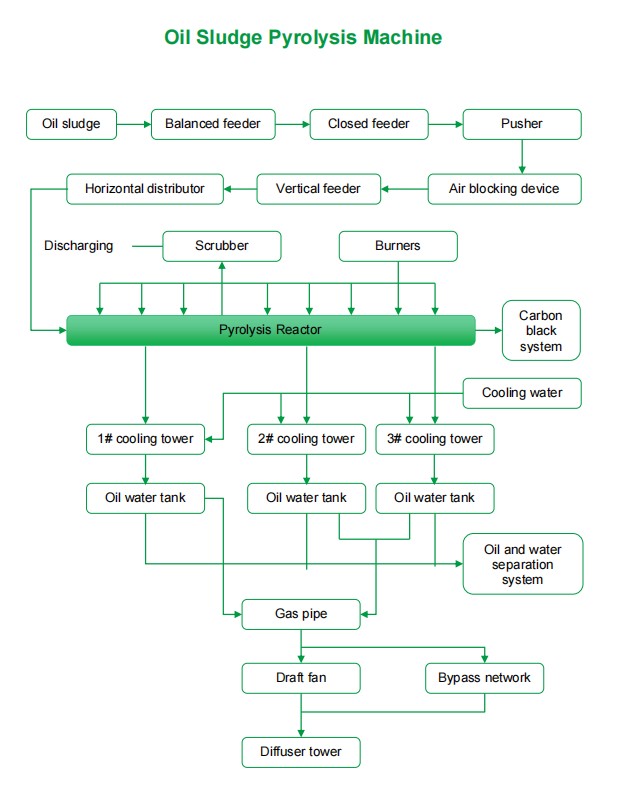All products
Contact us

This equipment uses indirect heating under high temperature conditions. After the petroleum hydrocarbons and water in the sludge volatilize, the oil and gas resources are recovered, so as to realize the harmless treatment of the sludge, recover the waste oil for comprehensive utilization, and recover the non condensable gas as the fuel gas of the unit.
The oil sludge in the storage warehouse is transported to the feed hopper through the grab bucket machine, and then transported to the cracking furnace by the vacuum screw feeder. The materials entering the furnace are evenly distributed by the distributor in the furnace without oxygen. There is a guide to move the materials toward the discharge direction. With the increase of material temperature, the generation of water vapor and oil gas of the materials makes the furnace produce micro positive pressure, and the micro positive pressure gas is discharged from the oil gas outlet. The heavy oil and gas of steam oil and gas will enter the cooling system and be reduced to liquid after entering the fractionating tower. The gas with long carbon chain (dry gas) generated at a temperature above 360 ° C is discharged from the oil and gas separation port to the tempering device for discharge, and the discharged gas can be sent into the furnace for combustion. Pyrolysis slag is sent to the closed slag hopper through a two-stage screw conveyor (with a water jacket for cooling) and a hoist, and the temperature of the pyrolysis slag is reduced from 185 degrees to below 70 degrees. The slag outlet of the slag hopper is sprayed with spray water for dust suppression, and the pyrolysis slag is sent out for comprehensive utilization. The oil content (TPH) of the treated pyrolysis residue is generally less than 0.3wt%, far less than 2wt%. The combustion waste gas of cracking furnace is discharged through 35m exhaust funnel after quenching, activated carbon adsorption and bag type dust removal.
(1)Under high temperature, indirect heating is carried out to volatilize the petroleum hydrocarbons and water in the sludge, recover the oil and gas resources, and realize the harmless treatment of the sludge. The recovered waste oil is transported for comprehensive utilization, and the recovered non condensable gas is used as fuel gas of the unit.
(2) The process principle is to transform the heavy components of oily sludge into light components through pyrolysis under anaerobic conditions, and then recover the volatile organic components. The vaporization process mainly includes the following two stages:
I Evaporation stage: when the temperature is lower than 450 ℃, light hydrocarbons with low boiling point volatilize from oily sludge;
II reaction stage: when the temperature exceeds 450 ℃, the heavy oil starts to crack, molecules at about 500 ℃ will generate free radicals due to thermal activation, and a series of free radical reactions will take place. On the one hand, the reaction will be carried out towards the cracking direction of generating small molecule hydrocarbons, on the other hand, the reaction will be carried out towards the condensation direction of coking and carbon generation, and finally four products will be generated: oil, water, non condensable gas and coke sand. In this stage, the maximum temperature in the cracking furnace can reach 600 ℃.
According to the production statistics of similar process equipment provided by the owner of the cracking furnace facility, the distribution of three-phase products of oily sludge after low-temperature pyrolysis treatment is generally about 40% of solid products (powder, almost no water), about 54% of liquid products, and relatively low gas products; In addition, oily sludge is pyrolyzed under anaerobic conditions, and it is almost impossible to generate dioxins, that is, the non condensable gas basically contains no dioxins, and the combustion temperature of the non condensable gas, hot gas and air after mixing can reach more than 1400 ℃, so the waste gas from the fuel combustion of the cracking furnace basically does not contain dioxins.
By clicking 'Allow All', you agree to the storage of cookies on your device to enhance site navigation, analyze site usage and assist with our marketing efforts.




